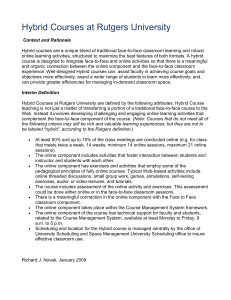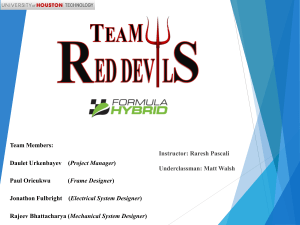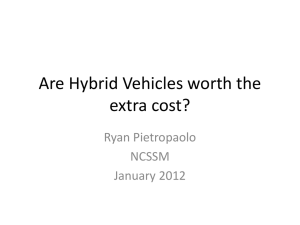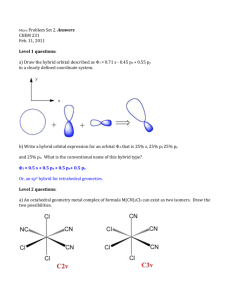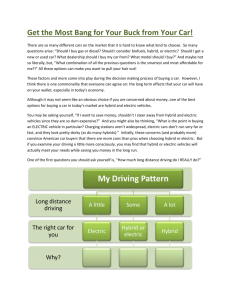Francisco Angel Writing 340 April 7, 2013 The Hybrid Method: From
advertisement
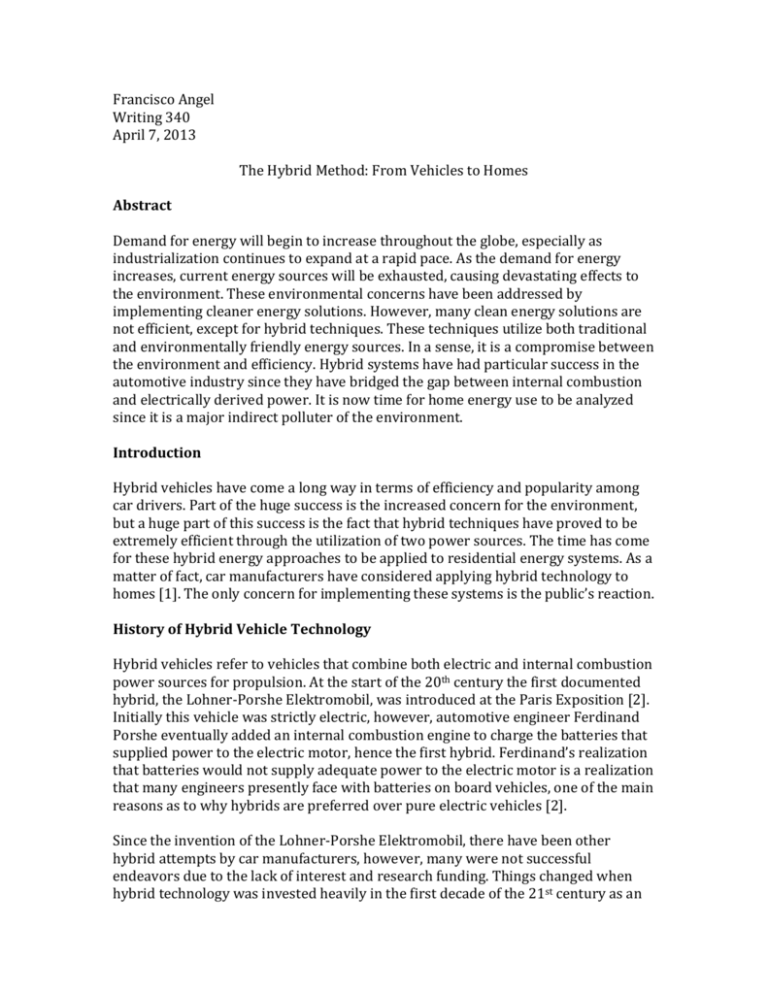
Francisco Angel Writing 340 April 7, 2013 The Hybrid Method: From Vehicles to Homes Abstract Demand for energy will begin to increase throughout the globe, especially as industrialization continues to expand at a rapid pace. As the demand for energy increases, current energy sources will be exhausted, causing devastating effects to the environment. These environmental concerns have been addressed by implementing cleaner energy solutions. However, many clean energy solutions are not efficient, except for hybrid techniques. These techniques utilize both traditional and environmentally friendly energy sources. In a sense, it is a compromise between the environment and efficiency. Hybrid systems have had particular success in the automotive industry since they have bridged the gap between internal combustion and electrically derived power. It is now time for home energy use to be analyzed since it is a major indirect polluter of the environment. Introduction Hybrid vehicles have come a long way in terms of efficiency and popularity among car drivers. Part of the huge success is the increased concern for the environment, but a huge part of this success is the fact that hybrid techniques have proved to be extremely efficient through the utilization of two power sources. The time has come for these hybrid energy approaches to be applied to residential energy systems. As a matter of fact, car manufacturers have considered applying hybrid technology to homes [1]. The only concern for implementing these systems is the public’s reaction. History of Hybrid Vehicle Technology Hybrid vehicles refer to vehicles that combine both electric and internal combustion power sources for propulsion. At the start of the 20th century the first documented hybrid, the Lohner-Porshe Elektromobil, was introduced at the Paris Exposition [2]. Initially this vehicle was strictly electric, however, automotive engineer Ferdinand Porshe eventually added an internal combustion engine to charge the batteries that supplied power to the electric motor, hence the first hybrid. Ferdinand’s realization that batteries would not supply adequate power to the electric motor is a realization that many engineers presently face with batteries on board vehicles, one of the main reasons as to why hybrids are preferred over pure electric vehicles [2]. Since the invention of the Lohner-Porshe Elektromobil, there have been other hybrid attempts by car manufacturers, however, many were not successful endeavors due to the lack of interest and research funding. Things changed when hybrid technology was invested heavily in the first decade of the 21st century as an environmentally concerned market grew at a rapid pace [3]. The initial success of the hybrid had a lot to do with its marketable image, which in turn allowed car manufacturers to dedicate a substantial amount of resources for further hybrid technology research, leading to improved vehicle performance over the years since the year 2000 [3]. Hybrids have provided excellent gas mileage, where they gained uttermost popularity during a gasoline crisis when U.S. gas prices tripled between the years 2006 and 2008 [3]. These vehicles, in the near term, seem to be the best choice in answering emissions questions, however, it is unknown whether hybrid vehicles can keep up with long-term competition with more efficient internal combustion engines and other emerging propulsion alternatives. How Hybrids Work The term hybrid can be applied to many objects and methods, describing these as mixtures of several components. The most well known hybrid is the hybrid vehicle, which utilizes both a gasoline engine and an electric motor [4]. Both power sources can be arranged in three different ways: in parallel, in series, or in a dual configuration. The latter is a combination of both a parallel and series system. In a parallel hybrid, both the engine and electric motor drive the wheels of the car, where in a series hybrid the engine generates electricity for electric motor to drive the wheels [4]. The figure below is a diagram of a parallel hybrid system, which shows how both power sources do not influence each other. Figure 1: Parallel hybrid system schematic. The engine and electric motor are completely separated from each other, but they both supply power to vehicle's wheels [4]. A dual hybrid system has been the most rewarding since the engine is responsible for both generating electricity and driving the wheels— a mixture of both parallel and in series systems. Although a dual hybrid system is the most efficient, a parallel hybrid is the system that can serve as a model for residential homes. Of course the hybrid vehicle’s components, such as engine and motor, would be replaced by power generation components for homes. In other words, a hybrid home would only be a derivation of hybrid vehicle techniques. From Vehicles to Homes Applying hybrid techniques to homes can reduce energy costs by creating a system where multiple power sources exist [5]. Taking the parallel hybrid system as a model, a hybrid home system would contain two power sources and a battery. The primary reason as to why a parallel system is the best type of hybrid system for a home is due to the fact that one power source can be completely shut-down during appropriate times. In other words, both power sources do not directly rely on each other. Consider the following system shown in the figure below. Figure 2: Diagram demonstrating a potential hybrid home system. Both the fuel converter (left) and solar panels (right) supply power to the home, where the excess energy is stored in the battery (center). Original image. This sort of system can be applied to any home regardless of size. In this system there is a fuel cell converter, a solar panel, and a battery. Once again, both power sources run parallel to each so they do not affect each other in any direct way, but they do connect to the battery that stores any excess energy that is collected or converted. The purpose of the system is to place most of the load demand on the solar panel(s), perhaps with a 60%/40% (solar/fuel cell) ratio in order to reduce the cost of the fuel that must be replenished every so often. The only time the fuel cell converter will be running at full capacity is when energy demand is high in the home, perhaps during hours when the Sun has already set, since the solar panels cannot collect energy without the Sun. Exactly like a parallel hybrid vehicle system, this hybrid home system would completely shut-off any power generation from the fuel cell converter during times when there is not a significant demand for energy. For example, a hybrid vehicle in a parallel configuration typically shuts-off the internal combustion engine when the vehicle travels at low speeds or if it is at a complete stop, which has yielded impressive gas mileage numbers. In terms of the hybrid home system, the solar panel will be taking on most of the energy demand unless there is a substantial energy need or if there is not enough sunlight on a given day. Throughout the power generation process, any excess energy will be stored in a battery, therefore, whenever there is enough energy stored, the fuel cell converter will slow down on the fuel consumption. Every component within this stated hybrid system stems from existing technology, allowing for potential implementation. Fuel cell converters need a fuel to convert chemical energy to electrical energy, which can be a significant cost in replenishing the fuel. To make the fuel cell converter a much more valuable component of the system, the exhaust heat from the electrochemical reaction can be used to warm the domestic water supply, thus reducing the cost of water heating. On the other hand, solar panels are expected to collect as much energy as possible during daylight since there is no direct cost in converting the Sun’s energy to electrical energy. Developing a hybrid system for a home is not a simple task, but the outcome can be very great. Unlike vehicles, residential homes vary and are rarely the same. For instance, there can be homes that do not have many appliances, whereas there can be homes that have every possible appliance [5]. There are also homes that are significantly larger than other homes, where energy usage can vary greatly, adding more to an already complex situation. Compared to vehicles, you get what engineers designed the car to be. This leads to the question on whether to market hybrid home systems as custom-made systems or as built-in systems to newer homes. Future The future of hybrid energy techniques highly depends on its expansion into other areas, particularly in deriving similar systems to fit residential energy needs. For the time being, hybrid vehicles have satisfied the needs of cleaner and more fuelefficient vehicles. However, it is not very probable that hybrids will outcompete much more fuel-efficient and high-performing internal combustion engine vehicles in the near future [3]. This can easily bury hybrid techniques in a sea of science and engineering ideas, hence why it should be pushed into the area of residential energy needs. When it comes to residential homes, hybrid energy systems can be marketed as individually sold systems based off of maximum power generation levels. [6] It seems that in the near future, every home will be generating their own power, making the grid more and more obsolete, which will create a huge need for home energy systems. Hybrid energy systems are not only efficient but are very clean energy sources. References [1] "Toyota Eyes 'Hybrid Home'" Ward's Auto World Sept. 2009: n. pag. Web. 2 Apr. 2013. <http://search.proquest.com.libproxy.usc.edu/docview/196365040>. [2] Anderson, Curtis D., and Judy Anderson. Electric and Hybrid Cars: A History. Jefferson, NC: McFarland, 2005. Print. [3] Hantula, Richard, and Debra Voege. How Do Hybrid Cars Work? New York: Chelsea Clubhouse, 2010. Print. [4] Underhill, William. "Hybrid Homes." Newsweek [New York] 20 Sept. 2004, 144th ed., sec. 12: E18-20. Print. [5] Patterson, Brian. "Hybrid Cars Meet Hybrid Buildings." Environmental Design and Construction 14.5 (2011): 50-51. Web. 6 Apr. 2013. <http://search.proquest.com.libproxy.usc.edu/docview/872192783> [6] Horst, Gale R., Jiannong Zhang, and Andriy D. Syvokozov. Total Home Energy Management System. Whirlpool Corporation, assignee. Patent 60389013. 13 June 2003. Print.


